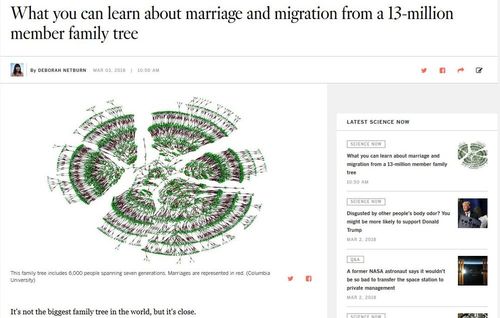From the Los Angeles Times:
What you can learn about marriage and migration from a 13-million member family treeCharles Darwin marrying his first cousin Emma Wedgwood in 1839 is a good example of this.By DEBORAH NETBURN
MAR 02, 2018 | 3:20 PM
… Armchair genealogists and a team of computers scientists have assembled a massive family tree that includes 13 million individual members and spans an average of 11 generations.
A study describing the tree, published this week in Science, also details some of what we can learn from this crowdsourced data. For example, it reveals when people stopped marrying their cousins, whether men or women traveled farther from home for marriage, and provides clues about how longevity is inherited. …
The researchers found that on average there was a 2% error when listing a person’s father, and a 0.3% error for a mother. …
To correct these errors the team developed computer programs that “pruned” the tree, removing invalid relationships. After doing that, they generated 5.3 million disjointed family trees — the largest of which included 13 million individuals.
… “We have much more representation of Western populations, mostly from Europe and the U.S.,” Erlich said. “And from the U.S. it is mostly from Caucasians rather than other ethnicities.” …
For example, after studying migration patterns in the tree they found that women leave their hometown more than men, but when men move, they tend to move much farther. This pattern has continued for a long time. It was true 300 years ago, and continues to be true today, the authors said.
In another line of inquiry, the data were used to determine when people stopped marrying close relations.
The researchers found that prior to 1750, most marriages in their data set occurred between people born about 6 miles from each other. After the start of the Industrial Revolution in 1870, however, that distance rapidly increased to about 60 miles.
You might think that as people traveled farther to find a spouse, they would marry people who were more distantly related to them. And indeed, that was true. Eventually.
The authors report that between 1650 and 1850 the average genetic relationship of married couples was on the order of 4th cousins. After 1850 it was on the order of 7th cousins.
But, the researchers found something strange in the data. Between 1800 and 1850 the distance couples traveled to marry each other doubled — probably because rapid transportation made railroad travel possible in most of Europe and the United States. However, that increase in distance traveled to marry someone was accompanied by an increase in genetic relatedness between marriage partners.
In other words, during this 50-year period, people traveled farther to marry closer relations.
“Families dispersed, and people started taking the train to marry their cousin,” Erlich said.
This observation implies that it was changing social norms, rather than access to rapid transit, that was the primary trigger for people to search genetically further afield than fourth cousins when it came to finding a spouse, Erlich said.American reformers took the lead on researching cousin marriage and banning it, while the English researchers who might have spoke up on it mostly did not. Darwin, worried about his ten children’s tendency toward ill-health, he asked his son George to research it. George said there wasn’t much to worry about, so Charles clammed up on the subject.
In contrast, American anthropologist Lewis Henry Morgan, who married his first cousin in 1853, was speaking out against cousin marriage in the 1870s.
Anyway, it sounds like the researchers are interested in getting more suggestions for what to research with their vast database.
I’m interested in “pedigree collapse” — how many fewer unique ancestors do you have than you have slots in your family tree. E.g., 40 generations ago you have a trillion slots for ancestors. But there weren’t a trillion individuals alive in about 800 AD or 1000 AD.
Understanding pedigree collapse is of course immensely important for thinking more lucidly about the scientific reality of race.
And here’s my 2007 VDARE article on Pinker’s big New Republic article on genealogy.











